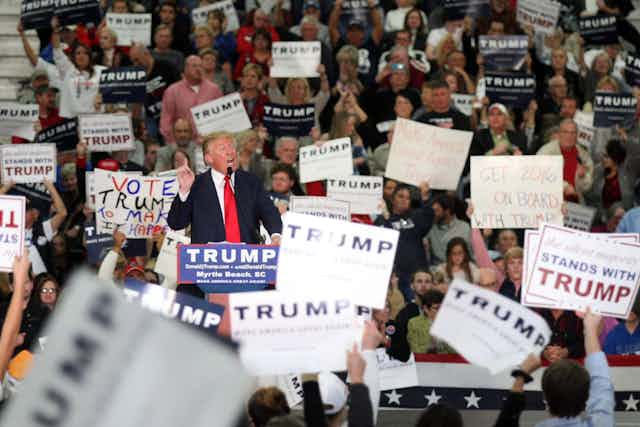U.S. President Donald Trump’s bigotry is no longer in question. Most recently he has called Haiti, the largest Black nation in our hemisphere, a “shithole” whose people “all have AIDS.”
The man’s a racist, period. So are many of his fans.
The puzzle is how Trump came to be a symbol of national pride for evangelical Protestants who value strict morality and good manners. In 2016, 80 per cent of white evangelicals voted for a thrice-married vulgarian of no evident piety, a slightly higher level of support than they showed for choir boy Mitt Romney and born-again George W. Bush. Why?
The quick answer is that these conservatives wanted anyone but Hillary Clinton and knew that Trump would appoint pro-life judges. And yet they’ve mostly stuck with The Donald through a rough first year, suggesting a real affinity rather than a marriage of convenience.
If we take a broader and deeper view of American history, we find that evangelical voters and Donald Trump share a version of that history, a master narrative of a chosen nation with special powers. It’s a long and twisted tale, a bloody saga torn from Scripture and sewn into too many American flags.

Pilgrims and founders
The story began with the New England Puritans, who saw themselves as pious seekers in a “heathen” land. The wars they waged against Indigenous peoples in the 1600s gave rise to best-selling captivity narratives, in which innocent white women endured long months in wild forests with the men who had just scalped their children.
The Ulster Scots who came to the middle and southern colonies of British North America in the 1700s had told similar tales about the savage Irish back home, and they easily recast the Creeks, Cherokees and Shawnees into the role of bloodthirsty infidels.
As men of the Enlightenment, the American Founders disliked such religious tribalism. They proudly called themselves “liberal,” by which they meant open to the rest of the world. They thought of race in environmental rather than biological terms.
But they did not see non-white people as full members of an American “nation.” That word meant not only political community but also the more intimate bonds of language and culture. (It comes from the Latin natio, birth).
Thomas Jefferson was not even sure if white Americans were a nation, given their diverse ethnicities. But he did call Blacks a hostile nation, an enemy within to go along with the Indigenous enemies beyond.

The War of 1812 was a watershed. Especially for Americans in the southern states, this was a harrowing war of survival against the British Empire and its non-white allies. It called for a new kind of patriotic rage. “The government has at last yielded to the impulse of the nation,” the pious Ulsterman and future president Andrew Jackson told his volunteers.
By this he meant that Americans were now free to wipe out the evildoers south of the Tennessee River — first the hostile “Redstick” Creeks and then any Indigenous communities or runaway slaves in their way — much as the Israelites had once waged holy war for the promised land west of the Jordan.
Endangered whiteness
To this way of thinking and feeling, the United States was not just a nation of white people. It was a nation of endangered white people whose right to vengeance came from God rather than from any manmade source.
The story spread through the 19th century, fed by “scientific” theories of race and the rapid conquest of everything south of Canada.
Often it wore an optimistic face. Providence had chosen them to spread the blessings of liberty, Americans believed. They were happy to shoulder the burden.
Whenever new groups sought new protections of law, however, the bloody epic was enacted all over again. Klansmen lynched Black men accused of raping white women in the 1890s. A second Klan targeted Jews, Catholics, Speakeasies and other signs of change in the 1920s. Their white gowns and burning crosses symbolized the racial “purity” they longed to inflict.
White nationalist themes also flourished during the long Cold War against godless communism. Most important here were the new mega-churches of the South and West, the religious descendants of the Puritans and Ulstermen who became a political force within the Republican Party during the 1970s and 1980s.
Although Trump never attended such churches, he embraced their national story. He entered politics in 1989 by calling for retribution for five men of colour (falsely) accused of raping a white woman in Central Park. He re-emerged in 2011 by claiming that Barack Obama was not a U.S. citizen — an African, not an American. He took the White House by promising to avenge “forgotten” Americans, and named Andrew Jackson his guide and inspiration.
All of this resonates with many white evangelicals as a kind of American gospel, making Trump sound honest no matter how many lies he tells. For everyone else, the challenge is to offer a new story about the national community, one rooted in common humanity rather than divine favour.

